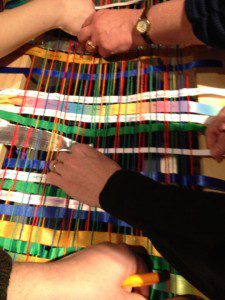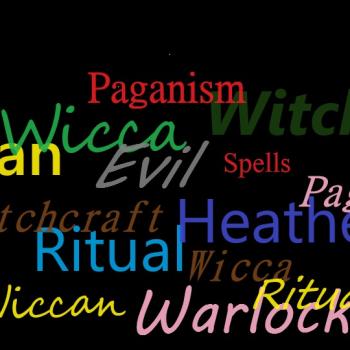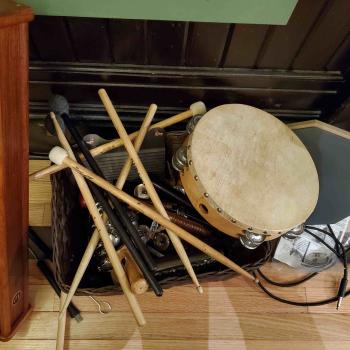 From time to time, people write to us at Gaia Community from CUUPS groups or UU congregations to ask us about our ritualist training program. As a teacher in that program, I’ve shared our curriculum, led some workshops, and had some lovely conversations with people on the subject. But the fact is, our training program can’t train your ritual facilitators to know what you need them to know and do what you need them to do. It’s been written and refined over the years to teach people how to lead ritual at Gaia Community, to tend to the unique relationships and process we’ve built. Every Pagan group has different needs, different ideas about ritual, different relationships in place, and so it makes sense to me that every group wishing to train priests or priestesses or ritualists or facilitators or whatever it is that your group calls its ritual leaders might want to develop their own program.
From time to time, people write to us at Gaia Community from CUUPS groups or UU congregations to ask us about our ritualist training program. As a teacher in that program, I’ve shared our curriculum, led some workshops, and had some lovely conversations with people on the subject. But the fact is, our training program can’t train your ritual facilitators to know what you need them to know and do what you need them to do. It’s been written and refined over the years to teach people how to lead ritual at Gaia Community, to tend to the unique relationships and process we’ve built. Every Pagan group has different needs, different ideas about ritual, different relationships in place, and so it makes sense to me that every group wishing to train priests or priestesses or ritualists or facilitators or whatever it is that your group calls its ritual leaders might want to develop their own program.
To that end, I’ve been working on the idea of a meta-training program: a series of discussions, questions, and ideas to consider for groups that want a training program. It’s smaller than a book, but bigger than a blog post, so I hope that I can present it here in a series of posts. I don’t put this forward as the one true right and only way, but rather some interesting possibilities that may be used, discarded, modified, or taken as a springboard for other discussions. These points should be useful to help build a program from scratch, or to modify an existing course (say, if you have a copy of our curriculum, or if you are using a text like Isaac Bonewits’ “Rites of Worship” or Shauna Aura Knight’s “Ritual Facilitation”).
When I talk to people about building a training program for their public ritual group, I usually start with the basics, and I’ll start there in this post as well.
-
What is the mission or purpose of your group? You don’t need a formal, corporate-like mission statement in order to answer this question, just for all of your leadership to be more or less on the same page when it comes to the question of why you exist. Is your purpose to celebrate the Sabbats and turn the wheel of the year? To educate the public about Pagan faiths? To honor a particular deity or set of deities? To connect Pagan people to one another? Your purpose may (and probably does) encompass more than one simple goal. If you don’t have a clear answer for your group on this point, it might be something to work on together. Your ritual work should help you achieve your purpose, or at least not interfere with your purpose, and new ritual leaders should probably know and be clear about what that purpose is.
-
Similarly, what are your group’s virtues or values? Are you working from the Seven UU Principles, the Nine Noble Virtues of Asatru, the Nine Virtues of ADF druidry, the Wiccan rede and the virtues laid out in the Charge of the Goddess, or any other particular set of values? Does your group have its own self-generated list of principles? These are things your ritual leaders should know about and be able to put into practice. These virtues and values can provide an ethical support for your ritual work. Not only do they tell you what sort of thing will not be appropriate in ritual, but also they can serve as excellent seeds from which to develop ritual. How can you create a ritual that teaches or strengthens this particular virtue or set of values?
-
Who does your group serve, or, to whom is it responsible? The gods? A particular deity or pantheon? The natural world? The ancestors? The people who attend? The wider Pagan community? Your neighborhood or city? Future generations? Again, your group probably has a responsibility to several different groups or individuals. This also should probably inform your ritual design; a group that feels a responsibility to the Earth or the natural world should probably teach its ritual leaders to avoid using disposable ritual items, for example. A group who feels responsible to humanity as a whole may orient its rituals around social justice work rather than (or in addition to) worship or magical work. A group who serves a particular pantheon of deities and no others will teach the style and structure of ritual appropriate to that pantheon, whereas a group who serves “the gods” as a whole may have a different style and structure in mind. And your group’s areas of responsibility may change. For example, on the question of serving deities or powers, Gaia Community is generally eclectic, and as likely to honor one deity as another, so long as building a relationship with that deity doesn’t bring us into conflict with our values. This eclecticism informs our usual ritual style, which is inspired by Wicca. However, each year, we choose a specific patron deity for the year. Rituals dedicated to honoring and communicating with that deity may have a structure that is suitable to the deity in question – this year we are honoring Brigid, so we will likely have a lot of rituals inspired by druidic tradition rather than our usual neo-wiccan style.
-
Among the people in your group, what faiths and beliefs are represented? The nature of UU Paganism seems to be a great diversity of belief, so it’s very possible that a UU Pagan group will have the opportunity for a lot of interfaith work just within its own membership. One of the discussions we have early in the process of Gaia’s ritualist training is on the specific beliefs of every member of the class and the instructors. This almost always yields results consistent with the old Pagan adage that if you ask any number of Pagans a question, you’ll get twice as many different answers as people. This understanding carries over into ritual design; everything we do in ritual has to leave space for different beliefs about deity, magic, and basically everything else. We can’t maintain any sort of orthodoxy, but we strive for orthopraxy, all participants performing the same or similar ritual actions and getting some good result from them, while maintaining their own beliefs about the meaning of those practices. If you’re in a group like this, your ritual leadership training may need to include the art of giving permission for your participants to experience the ritual in their own way, and encouraging them to support one another’s work, even when it looks different. On the other hand, this may not be an issue in your group. If you’re organized for a particular faith or tradition, you are more free in your ritual work to assume that everyone in attendance will have similar beliefs. Your ritual leadership training may instead need to work on the art of clearly communicating the imagery and focus of each ritual action so that all your participants are working together to create a single clear ritual experience and amplify each other’s work.
Answering these four questions for your group can start to provide content for your ritualist training or development program. If your ritual leaders can get this information about the group, and have the opportunity to think through and discuss what that information means, they’ll have a clearer idea of what they’re trying to accomplish in their ritual design and facilitation. In my next post, I’ll talk about clarifying further what your group wants from its rituals and ritual facilitators, and then later, about developing relevant skills and knowledge to actually get there. I hope you’ll stay with me.

















